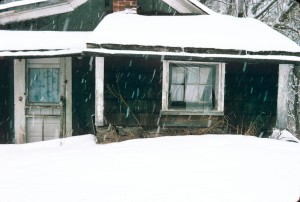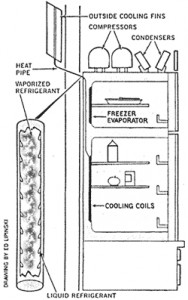Cold Weather Passive Refrigeration
In the mid 1980’s Sun Frost built a handful of refrigerators that used both passive and active cooling. We recently encountered renewed interest in this technology. We are currently refining the design and are building a prototype RF-16 for the Cold Climate Housing Research Center in Fairbanks, Alaska. In an exceptionally cold climate like Fairbanks the passive cooling can be used for both the refrigerator and freezer sections. With the new design the heat pipe transferring coolth from the outside is only ¼ inch in diameter.
Our previous design did not have an automatic means of turning off the passive cooling system when the refrigerator became too cold. Passive cooling could be reduced manually by partially covering the cooling fin mounted on the outside wall. These newer models will incorporate a thermostatically controlled solenoid valve to turn off the passive cooling system when the refrigerator gets sufficiently cold.
We are also building a passively cooled R-10, refrigerator only, for the Residential Energy Efficiency Project, a demonstration house in Kitchener, Ontario. These units will be tested in the field this winter. If the demand is there we will put these models back into production.
From a previous article on our Sustainability Page
If you live in a cold climate, your refrigerator is often running when the temperature outside is colder than it is in your refrigerator. A simple way of using the “coolth” from the outside to cool your refrigerator is by incorporating a heat pipe. A heat pipe is a passive device that transfers heat by evaporation and condensation. Steam heat and steam cooking vegetables are examples of heat pipes in use. Absorbed heat boils water, the steam then condenses and releases its heat while heating your house or cooking your food, the condensed water then drains back to the boiler.
A heat pipe can be used to transfer heat from a refrigerator compartment to the outside. When the temperature is colder outside than in the refrigerator, the liquid in the refrigerator boils, absorbing heat and cooling the refrigerator compartment. The refrigerant then condenses outside and runs back to the refrigerator (see diagram). The pressure in the tube changes with temperature, so the liquid always boils when the temperature is colder outside than in the refrigerator. This device acts as a one-way thermal valve, if the temperature is hotter outside than in the refrigerator heat is not transferred into the refrigerator.
Refrigerators we manufactured incorporating a heat pipe also contain an active cooling system. When the temperature outside warms and the refrigerator can no longer be passively cooled, a thermostat with a preset temperature will turn on the compressor and cool the refrigerator compartment. Installation required only drilling a _ inch hole for the heat pipe running from the refrigerator to the outside.
In the mid 1980’s we built about ten of these hybrid refrigerators. The models without a freezer compartment coupled very effectively with a solar system. Since during the winter when available sunlight is limited, the refrigerator is passively cooled and requires no energy to run. With our RF16, the freezer compartment consumes about 60% of the total energy consumed by the unit. During the winter, the heat pipe would decrease energy use by 40%. One of the passively cooled refrigerators is located at the Rocky Mountain Institute in Colorado, where winters are long and passive cooling is effective. Although these refrigerators operate effectively, sales were limited and we no longer manufacture that model.
Comments are closed.




Good article, Larry!
I’ll buy one! I’m building a home in Montezuma, CO where it would work great.
I’ve been scheming on how to cool a fridge with a fan to the outside, but the heat pipe solution is much more elegant.